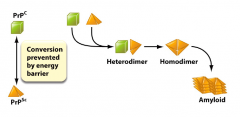![]()
![]()
![]()
Use LEFT and RIGHT arrow keys to navigate between flashcards;
Use UP and DOWN arrow keys to flip the card;
H to show hint;
A reads text to speech;
24 Cards in this Set
- Front
- Back
|
Prions
|
- infectious proteins (no DNA or RNA) |
|
|
Prion Protein (PrP)
|
- exist in all human and mammalian brains - believed to play a role in normal human function, function not known - 2 folded forms: cellular and Prion |
|
|
Cellular PrP
|
- non-infections |
|
|
Prion PrP |

- can be acquired - often by eating - can act as an enzyme, refolding cellular protein to make more Prion PrP - cells detect lack of cellular PrP, so they generate more which is eventually converted - build up of Prion PrP forms tangles or plaques which interferes with neuronal function - prion disease often called spongiform encephalopathies because of brain damage observed |
|
|
Creutzfeld-Jakob Disease
|
- Spontaneous: cellular PrP converts to Prion PrP for unknown reasons (40% of humans have a variation of cellular PrP that is more susceptible to folding |
|
|
Sources of Prions
|
- other animal sources: eyes, skeletal muscle - transplantation of nervous tissue and blood - Acquisition of Prion PrP through tainted medical supplies |
|
|
Prion Concerns
|
- incineration or special enzymes are required - human trials of drugs to stall CJD are ongoing |
|
|
Chlamydia
|
- Caused by obligate intracellular pathogens (Chlamydia trachomatis and pneumoniae) - Often silent - Can cause serious problems if untreated - Pelvic inflammatory disease in women - Testicular and urethral infections in men |
|
|
Gonorrhea
|
- incrementally developed resistance used in treatment over decades - most infected men exhibit symptoms - women are usually asymptomatic - reinfection is possible due to phase variation |
|
|
Selective Toxicity
|
- drug kills microorganism without harming host - May have side effects at high concentration - Chloramphenicol can interfere with our ribosomes (RBC development) - May cause allergic response - Must affect specific physiology to microbes (peptidoglycan cell wall, ribosome, DNA/RNA Polymerase structure, biopathway unique to bacteria) - Antibiotics should target essential function |
|
|
Penicillin
|
- inhibitor of cell wall synthesis is only effective during cell wall synthesis and antibiotic must be taken until all cells leave stationary phase |
|
|
Broad-Spetrum
|
- Effective Against Many Species |
|
|
Narrow-Spectrum
|
- effective against few or single species |
|
|
Source of Antibiotics |
- often modified chemically during synthesis to increase efficacy and decrease human toxicity |
|
|
Spectrum of Activity
|
- range of organisms over which a drug has an effect - most antimicrobial therapeutics affect a narrow group of related organisms with shared physiology |
|
|
Kirby-Bauer Disk Susceptibility Test
|
- multiple disks with different antibiotics - size of cleared zones reflect relative sensitivity |
|
|
Bacteriocidal
|
- many only affect actively growing cells - inhibitor of cell wall synthesis is only effective during cell wall synthesis and antibiotic must be taken until all cells leave stationary phase |
|
|
Bacteriostatic
|
- immune system removes infection |
|
|
Antibiotic Resistance
|
- growing problem - antibiotics overused - overprescribes, used in farm feed - exerts selective pressure for drug resistant strains - many strains become multiply drug-resistant |
|
|
Destroying The Antibiotic |
- antibiotic resistance mechanisms - many bacteria make beta-lactamase - destroys penicillin analogues |
|
|
Modifying the Antibiotic
|
- enzymes modify aminoglycosides (via acetylation, phosphorylation, adenylation) - can no longer bind the ribosome and interferes with translation |
|
|
Changes the Antibiotic Target
|
- modify target protein so that antibiotic no longer binds - most common streptomycin-resistance mechanism |
|
|
Drug Efflux
|
- antibiotic resistance mechanisms - via ABC transporters - multidrug resistance (MDR) exporter - pumps drug out of cell - confers resistance to several classes of antibiotics at once |
|
|
Essential Function
|

|

